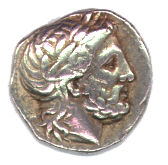Zeus

Zeus on Philip II tetradrachm
The greatest of Olympian gods, later associated with Jupiter in Rome. As the ancient poet Hesiod declared, no human being can know what fate to expect, for Zeus "humbles the proud and raises the obscure". He had at least five siblings among his Olympian "colleagues", and was father to numerous other gods and mortal heroes alike. Portrayed typically as a bearded and largely naked man, he is often recognized by his attributes, the main ones of which are the eagle, thunderbolt, scepter and Nike (personified Victory) figure. His many epithets and forms reflect the multifaceted powers he possessed, as much as the peculiarities of his worship to be found in different places.
Zeus' depictions are frequent themes on Greek and Roman provincial coinage, as is Jupiter on Roman imperial issues. They generally follow the conventions mentioned above, and are readily found on both obverses and reverses. However, it is always interesting to seek out various exceptions, as some of the Syracusan bronzes under the early 3rd c. BC reign of Hiketas, which characteristically feature a young, beardless Zeus, and refer to him explicitly (in Greek genitive), DIOS.
Search for coins with Zeus reverses.
